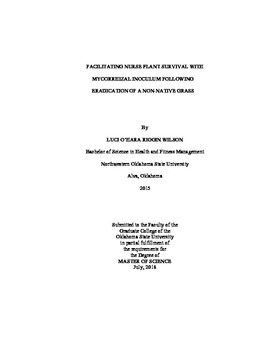| dc.description.abstract | Tallgrass prairies of North America are under threat from numerous anthropogenic disturbances including, but certainly not limited to, the introduction and expansion of non-native species. One potential mechanism for successful invasion by non-native plants is alterations of native soil microbial communities, including symbiotic arbuscular mycorrhizal (AM) fungi. In my study, I compared prairie sites invaded by a non-native grass to nearby undisturbed prairie, assessing underlying biological mechanisms of successful non-native plant invasion. I also evaluated the influence of native AM fungal communities on establishment and survival of native plant species following eradication of the invasive grass. Specific objectives of my study were: 1) compare biotic and abiotic characteristics following invasion by a non-native grass species (Bothriochloa bladhii) with undisturbed adjacent prairie, and 2) assess the effectiveness of AM fungal inoculum on survival of native grasses and forbs. I established replicate plots in invaded and adjacent undisturbed sites at Konza Prairie Biological Station (KPBS), Manhattan, KS. Plant species richness was reduced from 12-14 species/m2 in native prairie, to a monoculture of B. bladhii in invaded areas. Aboveground biomass production was greater, but root biomass lower, for B. bladhii, compared to native prairie. Invasion by B. bladhii reduced total microbial biomass, all microbial functional groups, including the relative abundance of AM fungi. To re-establish native plant species following eradication of B. bladhii, I inoculated native nurse plants, established under greenhouse conditions prior to outplanting, with AM fungal communities as follows: 1) a suite of AM fungal taxa isolated directly from KPBS soil; 2) fungal spores specifically selected as beneficial for native warm-season grasses and propagated under greenhouse conditions; 3) whole soil freshly collected from KPBS, including all soil microbial communities, and 4) a non-inoculated treatment. I found significant increases in survival of legume and non-leguminous forb species inoculated with either whole prairie soil or selected AM fungal spores, compared to non-inoculated plants. This suggests successful restoration may be achieved through propagation of AM taxa specifically selected for target native species, with fewer disturbances to native grasslands, potentially improving management decisions following removal of non-native species. | |
